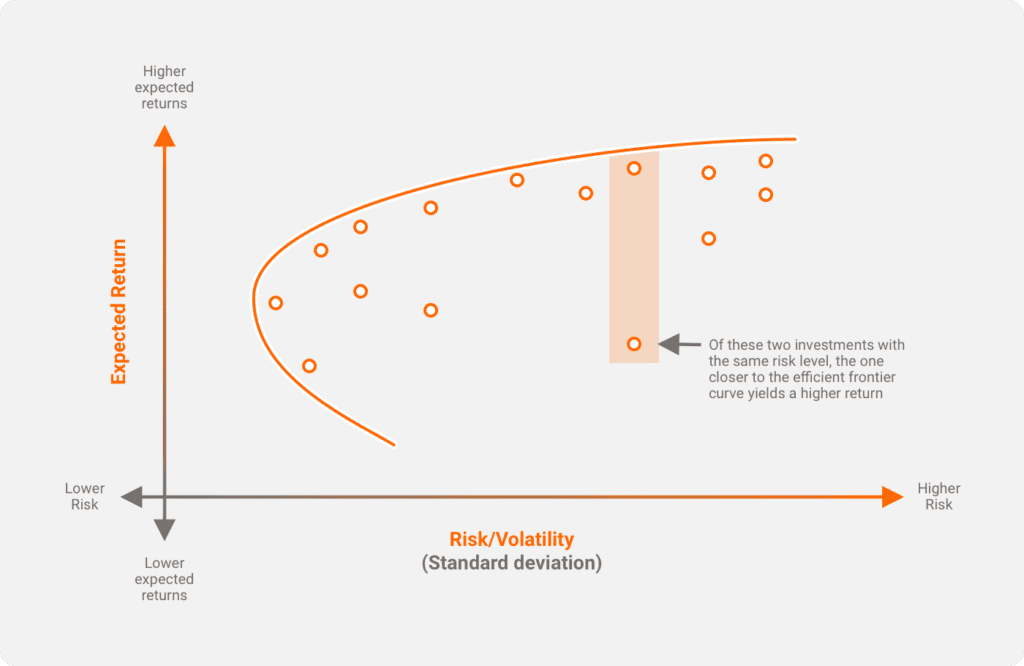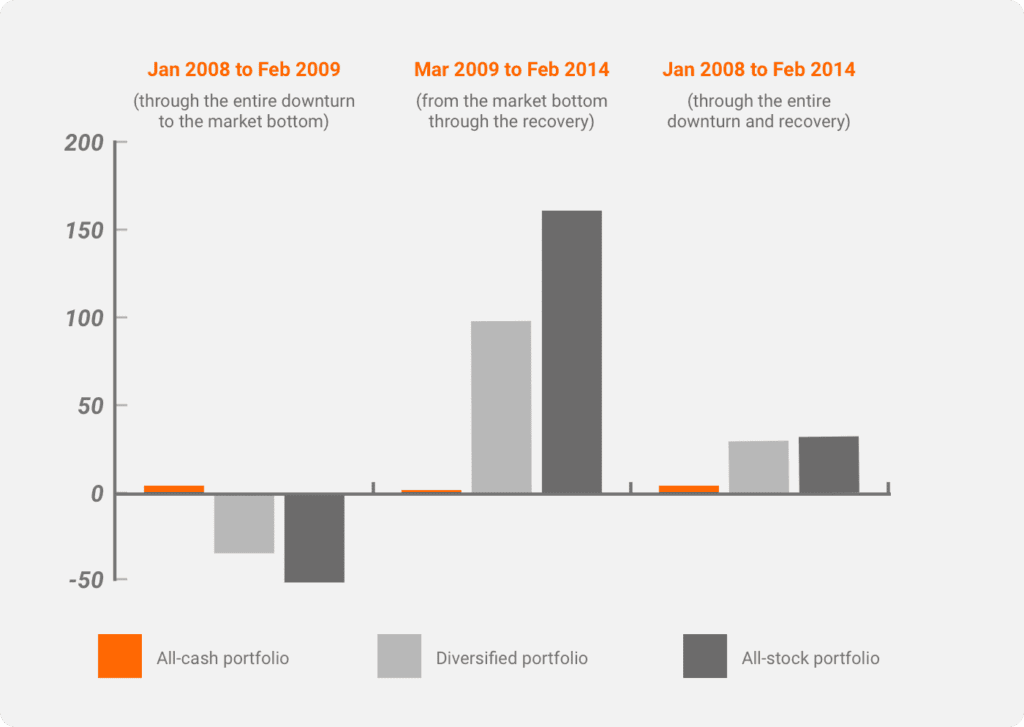Portfolio Diversification is a core concept in investing vital to financial planners, fund managers, and individual investors alike. Portfolio diversification is the risk management strategy of combining different securities to reduce the overall investment portfolio risk. It can help mitigate risk and volatility by spreading potential price swings in either direction across different assets. Correlation is a key variable in portfolio diversification. Finding assets with a relatively low correlation to equities and bonds is crucial for portfolio managers and financial planners to consider. However, it does neither guarantee a profit nor immunize against a loss.
Using the Correlation Coefficient for Portfolio Diversification
The correlation coefficient is a measure of how closely related two data series are. It measures the direction and extent of the linear association between two variables. A positive linear association between two variables occurs when the correlation coefficient is greater than 0. A negative linear association between two variables occurs when the correlation coefficient is less than 0. The coefficient can have a maximum value of 1 and a minimum value of -1. Financial investment may have high, low, or no correlation. Investing in securities with little to no correlation helps in constructing a diversified investment portfolio. However, correlation does not equal causation. If A is positively correlated with B, it could mean that A explains B, B explains A, or there could be a false correlation. In the latter case, further analysis should be carried out.
The correlation of investments can fluctuate along short-term or long-term periods. It is important to understand the correlation of portfolio investments in the context of volatility. In a period of high market volatility, such as an economic downturn, correlations may move towards a positive coefficient. Investments may follow this trend via a downturn.
You might also enjoy:
- Treasury Securities – Learn What They Are and How to Trade Them
- What is Short Selling? │ Examining a Popular Trading Strategy
What is the Purpose of Portfolio Diversification?
The purpose of portfolio diversification is portfolio risk management. A well-diversified portfolio will reduce its volatility because not all investments move together. Therefore, holding a variety of low or no correlation assets can reduce unsystematic risk.
An investing strategy that holds investments across asset classes, like equities, fixed income, commodities, and alternative investments like futures and forwards is less likely to experience a severe loss than a non-diversified portfolio. You can also achieve diversification within each asset class across geographical regions, currencies, and time.
Why Should You Diversify Your Portfolio?
Diversified portfolios can have lower exposure to risk, which may improve portfolio stability and earning potential. To build a diversified portfolio, one should clearly understand your investment goals and risk tolerance. If you invest intending to accumulate wealth for a retirement period, you could have a risk objective over a time period different from someone investing for short-term gains in the market. Next, we’ll lay out the key concepts for why portfolio diversification may be desirable in portfolio constructions.
Risk Management
Risk reduction is a key principle of portfolio diversification, and different types of risks will impact portfolio construction and wealth-building capacity.
Unsystematic risk, also known as diversifiable risk, is related to a specific asset class or sub-asset class. Such risks may include company-specific risk, sector risk, industry risk, or risks within a financial system. To reduce the risk of loss from unsystematic risk, an investor’s portfolio strategy should be to diversify across investments that do not share the same unsystematic risks. This could limit losses from a particular company, asset class, region, or industry and, at the same time, may increase earning potential in a portfolio by increasing portfolio efficiency.
Systematic risks affect the market as a whole, including movements of interest rates and inflation. It is difficult to predict economic recessions or inflation but holding a diversified portfolio, in the long run, can reduce losses in case any of those events materializes. The beta coefficient can help in measuring the degree of systematic risk of an investment. It measures the systematic risk of an investment or portfolio relative to the market as a whole. Diversifying across investments with lower betas may help in reducing some type of systematic risk.
Higher Portfolio Return and Lower Risk
A diversified portfolio tends to be a stable investment portfolio. A stable investment portfolio, in turn, may result in a better return. We should note that portfolio diversification does not eliminate risk, but it can earn a better risk-adjusted return if structured well. Diversification usually shows its value in the long term.
How to Diversify Your Portfolio?
Investors usually have some diversification in their portfolios already, ranging from basic asset allocation to cash management. However, asset allocation choice is the key to building an efficient portfolio that matches the investor’s risk tolerance. The trader’s first step is to determine their objective, appetite for risk, and any additional constraints. Next, we will take a look at some approaches to asset allocation aimed at achieving diversification.
Markowitz Modern Portfolio Theory
Modern portfolio theory was introduced by Harry Markowitz in 1952 and is one of the most famous portfolio diversification strategies. The theory’s basic premise is to structure your investment portfolio to maximize return at a given level of the efficient frontier’s risk curve. This is also known as the mean-variance framework (MVO) developed by Markowitz.

All portfolios that fall below the efficient frontier curve are considered not investable due to taking more risk for the same level of return. According to Markowitz, an efficient portfolio lies along the line of the efficiency curve and represents all efficient portfolios.
Asset Allocation According to Markowitz Modern Portfolio Theory
Markowitz recognized that adding assets to a portfolio with little to no correlation reduces risk by more than the weighted-average risk of the assets themselves, measured by the standard deviation. Therefore, mean-variance optimization is a model for determining the right mix of assets to achieve a desirable expected return on a portfolio given a risk level. Mean-variance optimization is widely understood and enables investors to identify portfolios with the best risk/return tradeoff (Sharpe Ratio). Therefore, this asset allocation approach may result in optimal diversification in a portfolio.
Other Asset Allocation Approaches as Means of Diversification
The “120 minus your age” rule
This rule is a heuristics asset allocation approach that leads directly to age-based equity vs. fixed income split. 120-age=percentage allocation to equities. This results in a decrease in equity exposure as investors get older.
The 60/40 stock/bond portfolio allocation
This is a simple asset allocation approach that chooses to skip the details of various optimization techniques. The basic premise of this approach is that when stocks declined, the prices of fixed income increased, providing loss mitigation characteristics in a portfolio.
The endowment model
It is an asset allocation approach emphasizing large allocation to alternative investments (such as real estate). By holding alternative investments, the correlation coefficient with other assets declines and improves portfolio diversification and potentially increases return potential.
The 1/N rule
Is one of the simplest asset allocation heuristics involving an equally weighted allocation of assets. This approach is an example of so-called naïve diversification. It is not computationally intensive and is simple to implement.
What Assets Can You Use to Diversify?
Portfolio construction could have different asset classes as a means of diversification. An asset class is a group of securities that share similar characteristics and behavior. There is a loss of diverse asset classes that we can break down further into subclasses. In general, a portfolio with a broader mix of asset classes will have broader diversification. Major asset classes include:
Equities
Stocks represent one of the riskiest asset classes and provide the opportunity for higher growth over the long term. However, in the short term, stocks carry greater risk due to market fluctuations. Equities in a portfolio provide diversification when combined with other assets. Moreover, equities increase in prices offering capital appreciation, provide income in the form of dividends, and serve as a hedge against inflation.
Fixed Income
Globally, fixed-income represents one of the largest asset classes in the financial markets. Fixed-income investments provide diversification in a portfolio, coupon payments as regular cash flow, and protection against inflation. Diversification tends to lead to more stable yields in financial portfolios. This is even more pronounced in a fixed-income portfolio. In their case, yields are typically lower due to the low correlation between these two asset classes.
Cash and Cash Equivalents
These include money market funds and short-term investments such as time deposits in a bank account. Money market funds are low-return assets that can be liquidated rather quickly to obtain cash. Due to the relatively lower risk of money market funds and time deposits, their returns are low.
Alternative Investments
Alternative investments have varying risk and return characteristics that differ from those of traditional stock and bond investments. Examples of alternative investments could include futures and forwards, private equity, hedge funds, real estate, commodities, and private credit. Many investors perceive these investments as long-term assets that may require them to look further into the future.
Building a Portfolio Diversification Strategy
Investing is a dynamic process that requires regular adjustments and modifications as market conditions change. A proper investment strategy and process are critical for building a diversified portfolio. To build a portfolio diversification strategy, three steps are of importance:
Create an Investment Plan
Craft your investment plan by tailoring it to your needs. Defining goals, your time horizon, and risk tolerance are crucial in this step.
Invest According to the Plan
After defining youkai goals, risk capacity, and time horizon, choosing a mix of asset classes that you consider appropriate for achieving those goals is the next step. A balanced allocation between asset classes should be achieved to build a diversified portfolio. Once you select the right mix of asset classes, then implementation can be executed.
Manage the Investment Plan
Portfolio monitoring is a regular step in portfolio management. Maintaining a portfolio according to the investment plan involves:
- Monitoring – Evaluating portfolio performance and risk periodically for changes in strategy.
- Rebalance – Portfolio allocation may stray from the Investment Plan due to price movements resulting from market performance. Rebalancing could be necessary to reset the portfolio according to the Investment Plan. You can rebalance it in a systematic or discretionary way, depending on your investment strategy.
- Revisit Investment Plan – It is advisable that at least once a year, or when your financial goals and risk tolerance change, you should revisit the investment plan to ensure it still meets your needs.
Top Mistakes in Portfolio Diversification
When constructing a diversified investment portfolio, investors should have some of their optimal asset classes and several investments in the portfolio according to the investment objectives. Investors can easily over-diversify their portfolio by including many investments and funds, but this does not lead to an optimal outcome. Over-diversifying will lead to loss of returns that could exceed the benefit of reducing risk.
When adding low or negative correlation investments in a portfolio, each investment reduces the portfolio risk and reduces the expected return. The optimal number of investments in the portfolio should be enough to eliminate the unsystematic risk but invest in the best securities with the highest potential of increasing returns.
Another potential mistake when diversifying is to do it just for the sake of diversification. Diversification should be part of your portfolio strategy and construction. However, one should not carelessly make investments in weak securities. Investing in low-quality sectors or asset classes will not necessarily improve portfolio diversification.
Herding behavior is defined broadly as an investor following the investment behavior of a crowd. Doing so is another mistake when diversifying a portfolio. Chasing hot sectors or markets may drift investors from investment planning and portfolio strategy, thus hurting portfolio diversification. Trends in markets come and go, and investors may hurt their portfolios by following herd behavior.
Examples of Diversified Portfolios
In the 2008-2009 bear market period, many investment portfolios lost value, but diversified portfolios were still able to prevent some losses. The following example illustrates three portfolios and their performance and behavior during the 2008-2009 bear market.

The diversified portfolio comprises 70% equities, 25% fixed income, and 5% short-term investments. The all-stock portfolio is 100% equities, and the all-cash portfolio is 100% cash. According to the chart above, the diversified portfolio incurred fewer losses than the 100% equity portfolio in a bear market. However, the diversified portfolio also lagged behind the 100% equity portfolio in the subsequent recovery. Meanwhile, it outperformed the 100% cash portfolio, capturing plenty of the subsequent rally’s gains. When considering the entire period of January 2008 to February 2014 (the entire downturn and recovery), the diversified portfolios and all-stock portfolio performance are relatively similar.
A diversified portfolio helps in reducing some of the losses while maintaining exposure during market recoveries. Diversified portfolios benefit from the long-term approach. When investors chase rising markets and market downturn flock to low-risk investment, they hurt their portfolio performance from a lack of discipline. Having a proper investment strategy should help investors maintain diversified portfolios.
Does Portfolio Diversification Have Disadvantages?
Having a solid investment plan should help in avoiding some pitfalls of diversification. The following are some disadvantages of portfolio diversification, but note that the list is not exhaustive:
Costs
Making much investment and different investment vehicles come at costs as investors must pay fees for those managed investment vehicles. Management fees deteriorate investment returns in a portfolio. There are also additional transaction costs associated with broadly diversified portfolios whenever rebalancing occurs.
Over-complication
Investors may include many investments in a portfolio without fully understanding them. Holding over 20 funds or multiple asset classes could complicate portfolio management when rebalancing is due and deciding what investments are appropriate. This could become a daunting task unless the investor is very knowledgeable and possesses the right information when making decisions.
Limit Gains
Holding a diversified portfolio may limit investors from achieving high gains in a shorter time period. The risk of adding too many investments to a portfolio is that some investments’ positive performance will be muted by the lack of performance from other investments.
Final Thoughts
Portfolio Diversification has never been as significant or as important as it is today. The traditional diversified portfolio of 60/40 equity and bonds have come into question due to the long-run decline in yields, which have gone negative in some countries, and may do the same in the US. The practice of buying treasuries in a risk-off sentiment is in doubt due to concerns of how much, if any, yields at a current level can dampen volatility. As US yields move close to zero-bound or go negative, the traditional diversification that these safety havens have provided in the past may fade.
In their most recent meeting in September 2020, the Federal Reserve indicated that they are not planning on dropping target rates into negative territory, which presents a challenge to investors regarding asset allocation and diversification. This foundation has been the assumption that in times of crisis, government bond prices rise when stocks fall. A major rethink on asset allocation strategy may be needed if that is no longer a reasonable expectation. Alternative investments such as futures and forwards, hedge funds, real estate, commodities, precious metals, and inflation-protected assets become more frequent additions to well-balanced portfolios.

